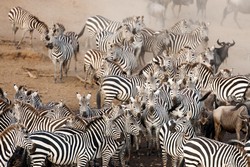Patterns protect moving prey from predators
The presence of high-contrast patterns, such as black and white stripes, does not conceal an animal, but may help it to avoid capture. The contrasting design, known as motion dazzle, may confuse predators by altering their perception of the movement, speed and trajectory of their prey. An EU-funded MOTDAZZ (Dazzle markings and movement as an anti-predator strategy) project investigated how motion dazzle can influence predator perception, thereby affecting prey capture rate. Researchers tested the visual effect of motion dazzle by creating an online game titled Dazzle Bug(opens in new window), where players act as predators by attempting to catch patterned targets as they move across the computer screen. These targets then evolve based on how easily they are captured. Easily caught targets are removed from the 'population', while the remaining targets produce a new generation of patterns, to simulate pattern evolution in response to predation. These patterns then continue to evolve as players attempt to capture each new set of patterns. From the results researchers were able to determine which patterns were most successful at avoiding predation when other selection pressures are removed. The patterns generated by Dazzle Bug were found to be effective in manipulating speed perception. Researchers then investigated the visual effect of motion dazzle on real predators, by presenting birds with moving targets bearing high contrast patterns. This provided a realistic predation scenario for identifying whether markings, shape and speed are important in evading capture. MOTDAZZ combined sensory ecology, physiology and cognitive research to test whether motion dazzle markings can influence prey capture rate by altering prey perception. It revealed which markings are most effective and how animals evolve to protect themselves from attack when moving.







